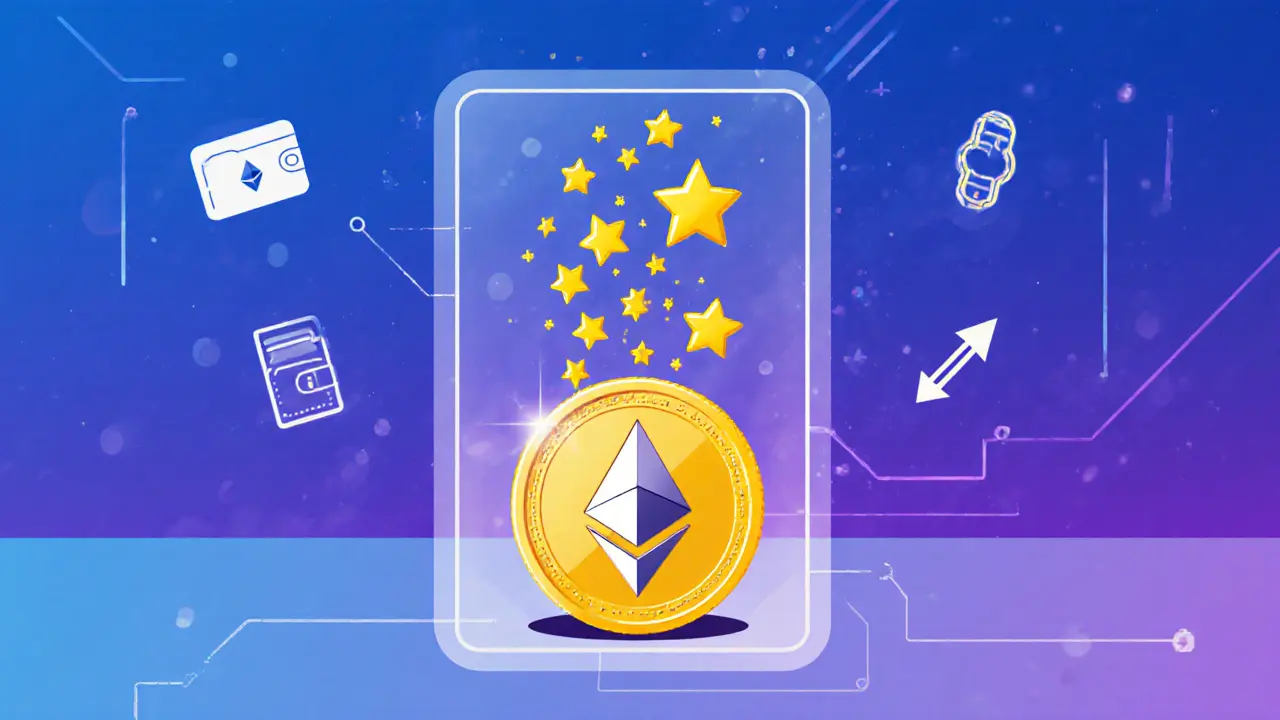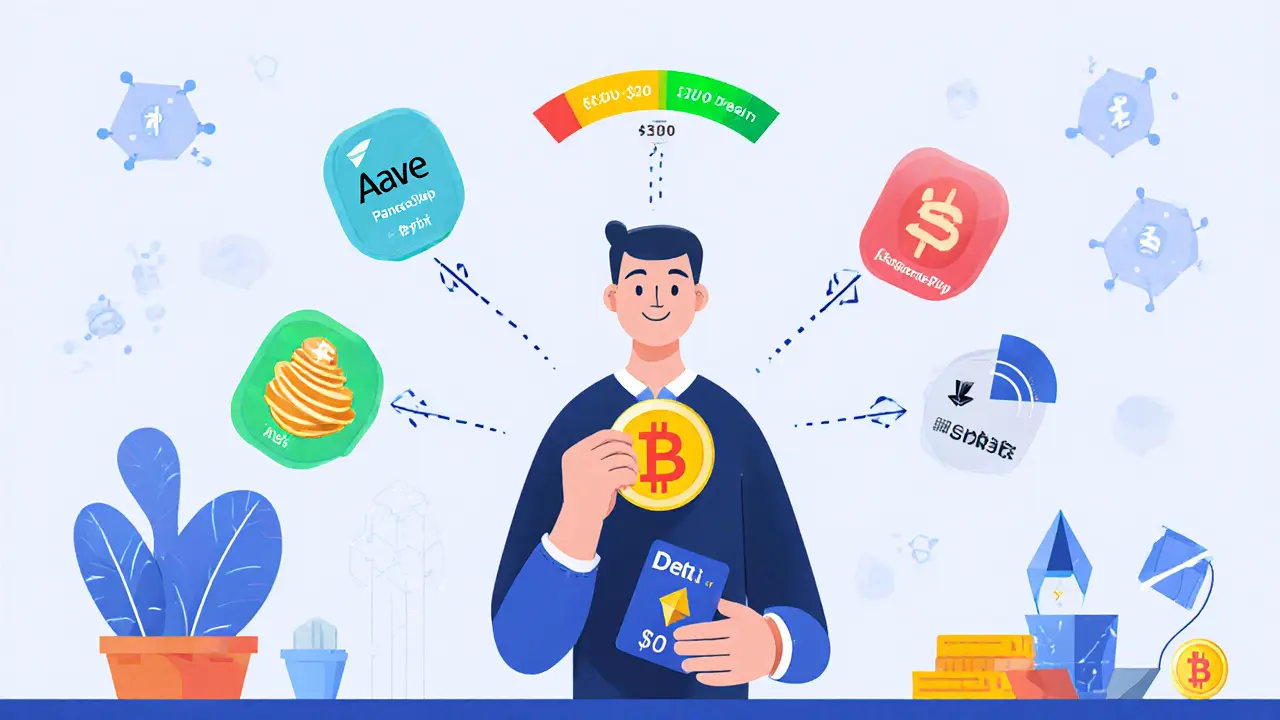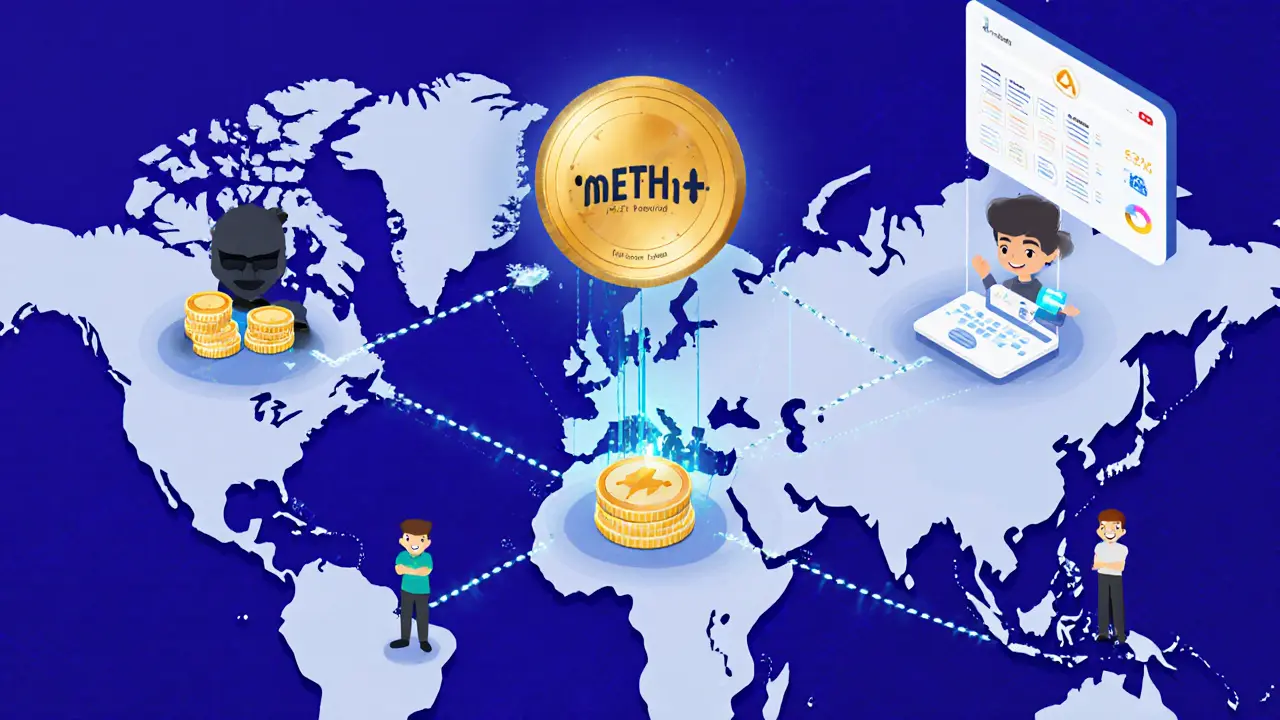
METH Staking Reward Calculator
Stake ETH with METH
Calculate your potential rewards from staking Ethereum using Mantle's liquid staking protocol. METH lets you earn staking rewards while keeping your assets liquid and usable in DeFi.
Your Rewards Estimate
* Current staking yield: ~3.5% annual. Values calculated using $3,500 ETH price. Actual rewards may vary based on market conditions.
Mantle Staked Ether (METH) is not a new cryptocurrency you buy on an exchange like Bitcoin or Solana. It’s a digital receipt-something you get when you stake your Ethereum (ETH) through the Mantle Network. Think of it like a coupon that proves you’ve locked up your ETH to help secure the Ethereum network, but unlike regular staking, this coupon can be traded, used as collateral, or moved around just like any other token. It’s ETH that’s working harder for you.
How METH Works: Staking Without Locking Up
When you stake ETH directly on Ethereum, your coins get locked for months. You earn rewards, sure-but you can’t sell them, send them to a DeFi app, or use them as collateral. That’s where METH comes in. Instead of holding onto locked ETH, you deposit it into the Mantle Liquidity Staking Protocol (LSP). In return, you get an equal amount of METH tokens. Each METH token represents one staked ETH plus all the rewards it’s earned since you deposited it. This isn’t magic. It’s smart accounting. The protocol tracks your staked ETH and automatically adds daily staking rewards to your METH balance. So if you staked 1 ETH and it earned 0.02 ETH in rewards over a week, your METH balance becomes 1.02. No manual claiming. No delays. Your rewards compound in real time. And here’s the kicker: you can send METH to any wallet, trade it on exchanges like Bybit, or use it as collateral in DeFi lending platforms. You’re still earning staking rewards, but now you’re also free to use your staked ETH like cash.Why Mantle? Layer 2 Efficiency
Mantle isn’t just another staking platform. It’s a Layer 2 blockchain built on top of Ethereum. That means it uses Ethereum’s security but handles transactions faster and cheaper. When you stake ETH to get METH, the actual staking happens on Ethereum’s mainnet. But every interaction with your METH-sending it, trading it, using it in DeFi-happens on Mantle’s network. This cuts gas fees by up to 90% compared to doing the same thing directly on Ethereum. If you’ve ever paid $20 to swap two tokens on Uniswap, you know how painful that is. With METH, you can do the same swap for less than $0.10. That’s why traders and DeFi users are switching: it’s not just about staking. It’s about doing more with your staked assets without breaking the bank.How METH Compares to stETH and rETH
You’ve probably heard of stETH from Lido or rETH from Rocket Pool. They’re the big names in liquid staking. So how is METH different?- stETH is the oldest and most liquid, but it trades at a slight discount to ETH because of redemption delays and market uncertainty.
- rETH is more decentralized but has higher complexity and fewer exchange listings.
- METH offers the same core benefit-liquidity while staking-but with the added advantage of Mantle’s Layer 2 infrastructure. Lower fees, faster transactions, and better integration with DeFi apps built on Mantle.

Where You Can Use METH
METH isn’t just sitting on your wallet. It’s already being used in dozens of DeFi protocols. You can:- Deposit METH into lending platforms like Aave or Curve to earn interest on top of your staking rewards.
- Use it as collateral to borrow other cryptocurrencies without selling your ETH.
- Trade it on centralized exchanges like Bybit, KuCoin, and OKX.
- Swap it for other tokens on decentralized exchanges like PancakeSwap or SushiSwap, all with low fees thanks to Mantle’s Layer 2.
How to Get METH
Getting METH is simple if you already use Ethereum wallets:- Connect your wallet (MetaMask, Coinbase Wallet, etc.) to the official Mantle Liquidity Staking Protocol site.
- Deposit ETH. You’ll need at least 0.1 ETH to start.
- Confirm the transaction. It takes about 10-20 seconds on Mantle’s network.
- Receive your METH tokens instantly.
Market Stats and Adoption
As of October 2025, there are 346,673 METH tokens in circulation. That’s backed by roughly the same amount of ETH, plus accumulated rewards. The total value locked (TVL) in the Mantle staking protocol sits at over $1.5 billion, making it one of the top three liquid staking protocols in the entire Ethereum ecosystem. METH trades between $3,900 and $4,400 depending on the exchange, and its 24-hour volume hovers around $700,000. Price movements are stable-usually under ±0.5% daily-because it’s tightly pegged to ETH’s value plus staking yield. There’s no pre-mine. No ICO. Every METH token was created by someone staking real ETH. The Mantle EcoFund, backed by Polychain, Dragonfly, and 20 other top VCs, has put $200 million into projects that boost METH’s utility. That means more DeFi apps, more integrations, and more places where you can use it.
Risks and Considerations
No system is perfect. METH has risks:- Smart contract risk: The code could have bugs. But it’s been audited by multiple firms, and the protocol has operated without a single exploit since launch.
- Market risk: If ETH drops sharply, METH will drop too. It’s still tied to ETH’s price.
- Adoption risk: It’s newer than stETH. Fewer people know about it. That could mean lower liquidity on smaller exchanges.
Who Should Use METH?
If you’re holding ETH and want to earn staking rewards without losing access to your funds, METH is one of the best options available. It’s ideal for:- DeFi users who want to maximize yield across multiple protocols.
- Traders who want to keep exposure to ETH while using their staked assets as collateral.
- Investors tired of paying high gas fees to move their staked ETH.
- Anyone who wants to participate in Ethereum’s security without locking up their coins.
The Bigger Picture
METH isn’t just a token. It’s part of a shift in how we think about staking. The future isn’t about locking up assets and waiting. It’s about making them work harder-earning rewards, enabling lending, powering apps, and moving freely across chains. METH is one of the clearest examples of that future already here. The Ethereum network is growing. Staking is becoming mainstream. And liquid staking derivatives like METH are making it possible for everyday users to participate without technical barriers or financial friction. In a few years, we might look back and wonder why anyone ever staked ETH without getting METH in return.Is METH the same as ETH?
No. METH is a liquid staking derivative that represents staked ETH plus accumulated rewards. You can’t use METH to pay for Ethereum transaction fees or send it to a validator directly. But it’s pegged 1:1 to ETH + rewards and can be traded, lent, or used as collateral like ETH.
Can I unstake METH to get ETH back?
Yes, but not instantly. To withdraw your ETH, you must redeem your METH through the Mantle protocol. The redemption process takes 1-2 days because it requires coordination with Ethereum’s consensus layer. During that time, you stop earning rewards on the redeemed portion.
Is METH safe?
METH is built on audited, non-custodial smart contracts. Your ETH never leaves Ethereum’s security. Mantle Network doesn’t hold your funds. The protocol has been live since late 2023 with zero exploits. Like all DeFi, it carries smart contract risk, but it’s among the most secure liquid staking options available.
Where can I trade METH?
METH is listed on major exchanges including Bybit, KuCoin, and OKX. It’s also available on decentralized exchanges like PancakeSwap and SushiSwap via Mantle’s Layer 2 network. Always use official links to avoid fake tokens.
Do I pay taxes on METH rewards?
In most countries, staking rewards are treated as income when received. Each time your METH balance increases due to rewards, that’s a taxable event. Keep track of your daily balance changes and consult a crypto tax professional in your jurisdiction.
Can I stake METH to earn more rewards?
No. METH itself doesn’t generate additional staking rewards. It already represents staked ETH and its rewards. You can, however, use METH in DeFi protocols to earn interest or yield farming rewards-but that’s separate from Ethereum staking.
Brett Benton
2 11 25 / 10:37 AMMETH is wild. You stake ETH, get a token that acts like ETH but also earns more ETH? And you can use it everywhere? This is like having your cake and eating it too, but the cake is literally making more cake.
Why didn't anyone think of this sooner?
Jeremy Jaramillo
3 11 25 / 19:44 PMLet me be clear - this isn’t just a technical upgrade. It’s a cultural shift in how people interact with staking. For years, we’ve been told to lock up and wait. Now we’re being given back agency over our assets. That’s not just smart finance - it’s empowering.
And the fact that it’s built on Ethereum’s security while operating on Mantle’s speed? That’s the kind of layered innovation that actually matters.
Bruce Bynum
4 11 25 / 16:16 PMMETH is just ETH that works harder. No lockup. No fees. No drama. Just earn and use.
Simple. Clean. Done.
Edgerton Trowbridge
6 11 25 / 11:28 AMIt is of considerable importance to note that the architectural design of the Mantle Liquidity Staking Protocol represents a non-trivial advancement in the domain of liquid staking derivatives. The decoupling of staking rewards from asset liquidity, while maintaining the underlying security guarantees of the Ethereum consensus layer, constitutes a paradigmatic shift in the economic incentives of delegated validation.
Furthermore, the integration of Layer 2 scalability solutions enables a dramatic reduction in marginal transaction costs, thereby facilitating greater participation from retail stakeholders who were previously excluded due to prohibitive gas expenditures. This innovation, therefore, should not be dismissed as a mere technical novelty, but rather as a foundational evolution in decentralized finance infrastructure.
Matthew Affrunti
8 11 25 / 06:10 AMI’ve been using METH for a few months now and honestly? It’s changed how I move in DeFi.
Used to pay $15 to swap something on Uniswap? Now I do it for 8 cents. And my staking rewards just keep adding up automatically. No more missing out on opportunities because my ETH was locked up.
Also, got some free NFTs just for holding METH in my wallet. Weird, but nice.
Eliane Karp Toledo
9 11 25 / 16:28 PMWait - so you’re telling me this ‘METH’ isn’t secretly a backdoor for the Fed to track your crypto? Or a way for Polychain to quietly drain liquidity?
They say it’s ‘audited’ - but who audits the auditors? And why does every ‘innovation’ in crypto end up being owned by five VC firms?
Don’t be fooled. This isn’t freedom. It’s rebranding control.
Phyllis Nordquist
10 11 25 / 18:30 PMThe structural integrity of the METH token, as a liquid staking derivative, is predicated upon the immutable consensus mechanisms of Ethereum’s proof-of-stake architecture. The protocol’s design ensures that each METH token is fully backed by underlying ETH and accrued staking rewards, with no fractional reserve or synthetic leverage involved.
Furthermore, the utilization of Mantle’s Layer 2 infrastructure does not compromise security; rather, it optimizes transactional efficiency while preserving the finality guarantees of the Ethereum mainnet. This constitutes a technically sound and economically rational evolution of liquid staking infrastructure.
David Roberts
12 11 25 / 01:58 AMso meth is just steth but on mantle? lol
you know what’s funny? the whole ‘layer 2 saves gas’ thing is just a bandaid. ethereum is still the backbone. and mantle? barely anyone uses it. the tvl is cute but it’s like a goldfish in a bathtub.
also, who even cares about low fees if you can’t cash out without a 48hr wait? that’s not liquidity. that’s a trapdoor.
Monty Tran
13 11 25 / 21:06 PMEveryone’s acting like this is the future
It’s not
It’s just another way to get your ETH stolen by a smart contract
And don’t even get me started on the tax implications
They’ll come for you later
They always do
Hanna Kruizinga
14 11 25 / 07:49 AMSo let me get this straight - you’re giving your ETH to a ‘protocol’ and getting back a token that’s worth the same thing... but you can’t use it to pay for gas? And you have to wait two days to get your ETH back?
That’s not innovation. That’s a scam with better branding.
Also, who the hell is Mantle? I’ve never heard of them. Why should I trust them?
And why is everyone so excited about something that literally does nothing new except charge you less to do the same thing?
Nabil ben Salah Nasri
14 11 25 / 18:38 PMOkay, real talk - I’ve been using METH for 6 months now. I’ve deposited 3 ETH, earned 0.4 ETH in rewards, and used it as collateral on Aave to borrow USDC to buy more crypto - all while paying less than $0.20 in fees per transaction.
And yes, I’ve swapped it on Bybit, used it in a gaming DAO, and even got airdropped some tokens just for holding it.
It’s not magic. It’s just… better. Like, way better.
Also, the team’s transparent. All code is open. You can verify every single deposit. No shady stuff.
And the fact that they’ve got $200M from Polychain and Dragonfly? That’s not noise - that’s validation.
Stop doubting. Start using.
🚀
alvin Bachtiar
15 11 25 / 23:58 PMLet’s cut through the crypto bro noise. METH isn’t revolutionary - it’s evolutionary. But evolution doesn’t mean it’s safe. The real risk isn’t smart contract bugs - it’s regulatory capture. The moment the SEC decides that liquid staking derivatives are securities, every exchange listing METH becomes a liability.
And don’t kid yourself - they’re watching. The fact that it’s pegged to ETH + yield makes it functionally identical to a bond. Bonds are regulated. Bonds are taxed. Bonds are scrutinized.
So yes, you’re earning 4% APY. But you’re also exposing yourself to a potential Class Action Lawsuit down the line.
And the ‘low fees’? That’s just a lure. The real value is in the network effects - and those are fragile.
Don’t be the last one holding METH when the rug gets pulled.
Bhavna Suri
17 11 25 / 15:39 PMThis is not a good idea. Why would anyone give their ETH to a third party? Even if it is a smart contract, it is still not safe. Also, the tax situation is very complicated. In India, we have to pay tax on every reward, even if we do not sell. This is very unfair.
And why is everyone talking about Mantle? I do not know this network. I only trust Ethereum.
Stay away from METH. It is too risky.
Genevieve Rachal
19 11 25 / 14:04 PMEveryone’s acting like METH is the answer to everything, but let’s be real - it’s just another layer of complexity wrapped in marketing.
You think you’re earning more? You’re just earning more tax events. You think you’re free? You’re still dependent on a protocol that could be hacked, frozen, or de-listed tomorrow.
And don’t even get me started on the fact that this is being pushed by VCs who’ve already cashed out their early bags.
It’s not innovation. It’s a pump disguised as progress.
Eli PINEDA
21 11 25 / 13:52 PMwait so meth is like… eth but with rewards built in? and you can trade it? so like… you dont have to wait 2 years to unstake? but then you get it back after 1-2 days? so its not instant?
why is this a big deal again?
i think i missed something
Debby Ananda
22 11 25 / 16:36 PMOh, so you mean… we’re not just staking ETH anymore - we’re participating in the post-modernist redefinition of liquidity within a decentralized, post-Ethereum-merge economic paradigm?
How poetic.
It’s like, your ETH is no longer a static asset - it’s a dynamic, self-compounding symbol of ontological freedom in the blockchain cosmos.
✨
Vicki Fletcher
22 11 25 / 23:50 PMOkay, so I just tried this. Deposited 0.5 ETH. Got METH instantly. Then I used it on Curve to earn more. Then I swapped half of it on PancakeSwap for some meme coin (don’t judge me).
Gas fees? Like 12 cents total.
And my balance went from 0.5 METH to 0.504 METH in 3 days - automatically.
I didn’t even have to claim anything.
And the best part? I didn’t lose my ETH. It’s still staked on Ethereum. Mantle just gave me a better way to move it.
Why didn’t I do this sooner?
Also - the website was super easy. No KYC. No forms. Just connect wallet and go.
Can someone explain why this isn’t everywhere yet?
Brett Benton
23 11 25 / 22:19 PMWait, so if I can use METH as collateral, and it earns rewards… can I borrow against it, then use the borrowed ETH to stake again and get more METH?
Is this like… staking on top of staking?
Someone tell me I’m not insane.